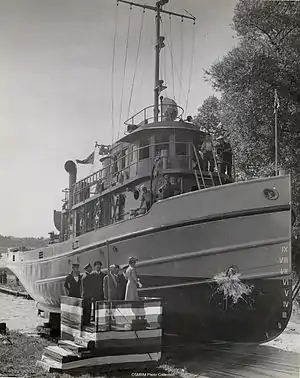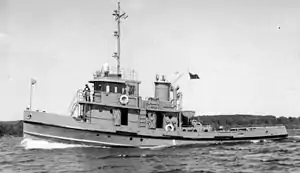Glen-class tug (1943)
The Glen-class tugs were a class of tugboats of the Royal Canadian Navy built during the Second World War. There were three designs of the tugboat; two were of steel-hulled construction and the other was wooden-hulled. Of the 20 of the class built, 16 were of the steel-hulled type; 11 built by Russel Bros. of Owen Sound, Ontario and 5 by Canadian Dredge & Dock Co., Kingston, Ontario. Of the four wooden-hulled type; three were built by McKenzie Barge and Derrick, Vancouver, British Columbia, and one by LeBlanc Shipbuilding, Weymouth, Nova Scotia.[1] All but one – Glendyne – were sold into commercial service after the war.
 Launch of the Second World War tugboat HMCS Glenside. | |
| Class overview | |
|---|---|
| Name: | Glen class |
| Operators: |
|
| Built: | 1943–1945 |
| In commission: | 1943–1979 |
| Completed: | 20 |
| General characteristics | |
| Type: | Tugboat |
| Displacement: | |
| Length: |
|
| Beam: |
|
| Draught: |
|
| Propulsion: |
|

Designs
Steel-hulled
The steel-hulled tugs all had the same hull design and dimensions, but were of two types; the Long House (Design A) and the Short House (Design B).[1]
The Long House-type had the main deck house extending aft over the engine room, with the bulwarks extending the entire length of the hull. They were powered by an 8-cylinder diesel engine built by the Vivian Engine Works, Vancouver.[1]
The Short House-type had a shorter main deck house with a trunk style house over the engine room, with raised bulwarks forward and aft. They were powered by a 6-cylinder diesel engine built by the Enterprise Engine & Foundry Company, San Francisco.[1]
Wooden-hulled
Three wooden-hulled tugs were built by McKenzie Barge and Derrick of Vancouver, the Glendevon, Glendon and Glenholme. Glenholme was completed in 1945, but was never commissioned into naval service.[1]
The Glenwood, built by LeBlanc Shipbuilding, Weymouth, Nova Scotia, was incomplete when the war ended. She was sold to St. John Drydock & Shipbuilding Co., completed and renamed Ocean Weka.[1]
Ships
- Steel-hulled Long House type
- M/V Glenada, launched 23 November 1943, sold post-war. Owned by Sandrin Bros., Sarnia, Ontario, until 1995, when acquired by Thunder Bay Tug Services, Thunder Bay, Ontario.[2][3]
- Glendower, launched 19 May 1943, commissioned 18 June 1943. Sold in 1946. Renamed E. A. Rockett (1946–1976), then Paul E. No. 1 (1976–2007). Owned by LeBrun Constructors, Ltd., Thunder Bay, Ontario, since 1983.[4]
- Glenora, launched 18 September 1943. Sold post-war. Renamed Lotbiniere and then Glenshiel. Owned by Glenshiel Towing Co, Ltd., Vancouver to 2004.[5]
- Glenmont, launched 27 October 1943. Sold to the Province of Newfoundland's Ministry of Public Works in 1947. Sold mid-1980s. In 1997 owned by Shepherd Boats Ltd. Rexdale, Ontario. Sold, rebuilt as a charter ship and renamed Carolina Borealis in 2002.[6]
- Glenlea, launched 20 July 1943. Sold to Foundation Maritime Ltd. in 1947 and renamed Bansaga. Sold to Gravel & Lake Services Ltd., Thunder Bay, Ontario, in 1964 and renamed George N. Carleton. Still in service in 2008.[7]
- Steel-hulled Short House type
- Glenbrook, launched 23 September 1944, sold post-war. Rebuilt in 1980 while owned by McKeil Work Boats Ltd., Hamilton, Ontario. Sold in 2000.[8]
- Glencove, launched 10 June 1944, commissioned 7 July 1944. Sold in 1946 to Anticosti Shipping Company, Montreal, and renamed Consol II. Sold to Canadian Dredge and Dock Co., Midland, Ontario, in 1953 and renamed Glen Rover. Sold 1986. In 2006 was for sale through Newcastle Boat Brokers Ltd., Nanaimo, British Columbia Currently owned and operated by Star Marine in Seattle Washington under the name Glen Cove.[9]
- Glendyne was launched in 1945 to serve at Halifax. She was sunk in 1957 while berthing the aircraft carrier HMCS Magnificent, but was re-floated a few days later, returning to serve the navy until retired in 1979. The ship was later sunk as a diver training site in the Eastern Passage, Bedford Basin, Halifax Harbour. Her wheelhouse was saved and installed on the wharf of the Maritime Museum of the Atlantic where it provides a ticket booth for Bluenose II when she is in port.[10]
- Glenevis, launched 21 October 1944 and sold post-war. In 1994 she was owned by McKeil Work Boats Ltd., Hamilton, Ontario. Sold in 2007.[11]
- Glenlivet, launched 11 July 1944, and commissioned 21 July 1944. In 1947 she was loaned to the Canadian Ministry of Public Works, and was renamed Glenlivet II. She was returned to the Navy in December 1973. Sold in 1977 to Francisco Petroleum Enterprises Inc. and renamed Canadian Franco. Reverted to Glenlivet II in 1984, and owned by Nadro Marine, Port Dover, Ontario, since 2001.[12]
- Glenside, launched 22 August 1944. Sold post-war, she was acquired from Remorqueurs et Barges Montreal Ltd., Valleyfield, Quebec, by McKeil Marine Ltd. Rebuilt in 1979, she was sold in 1998, and renamed Tycoon was working in Nassau, Bahamas.[13]
Plus five built by Canadian Dredge & Dock Co., types and names unknown.
- Wooden-hulled type
- Glendevon, currently under restoration.[14]
- Glendon
- Glenholme
- Glenwood
References
- "WWII Navy Tugs : Glen class". stevebriggs.netfirms.com. Archived from the original on 4 December 2012. Retrieved 24 July 2010.
- "Glenada". stevebriggs.netfirms.com. Archived from the original on 4 December 2012. Retrieved 24 July 2010.
- Jonathon Wilson (7 April 2007). "Tugboat crew rushes to the rescue". Thunder Bay: Thunder Bay Chronicle-Journal. Archived from the original on 3 December 2012.
Dawson and his three-man crew scrambled to get their failing pumps ready and took off into the harbour about the tugboat Glenada.
- "Glendower". stevebriggs.netfirms.com. Archived from the original on 3 December 2012. Retrieved 24 July 2010.
- "Glenora". stevebriggs.netfirms.com. Archived from the original on 3 December 2012. Retrieved 24 July 2010.
- "Glenmont". stevebriggs.netfirms.com. Archived from the original on 3 December 2012. Retrieved 24 July 2010.
- "Glenlea". stevebriggs.netfirms.com. Archived from the original on 3 December 2012. Retrieved 24 July 2010.
- "Glenbrook". stevebriggs.netfirms.com. Archived from the original on 3 December 2012. Retrieved 24 July 2010.
- "Glencove". stevebriggs.netfirms.com. Archived from the original on 3 December 2012. Retrieved 24 July 2010.
- "Glendyne". stevebriggs.netfirms.com. Retrieved 24 July 2010.
- "Glenevis". stevebriggs.netfirms.com. Retrieved 24 July 2010.
- "Glenlivet". stevebriggs.netfirms.com. Retrieved 24 July 2010.
- "Glenside". stevebriggs.netfirms.com. Retrieved 24 July 2010.
- "Glendevon Tugboat Restoration". glendevon.org. Retrieved 24 July 2010.
External links
| Wikimedia Commons has media related to Glen-class tugs. |